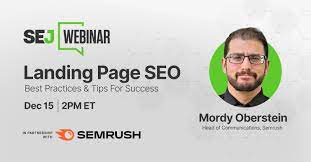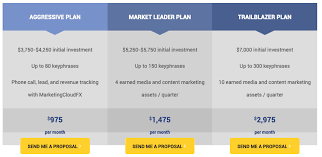The Importance of Landing Page SEO
When it comes to driving traffic to your website and converting visitors into customers, having a well-optimized landing page is crucial. Search Engine Optimization (SEO) plays a significant role in ensuring that your landing page ranks well in search engine results and attracts the right audience.
Key Elements of Landing Page SEO
Relevant Keywords: Incorporating relevant keywords into your landing page content helps search engines understand what your page is about and improves its visibility in search results.
Meta Tags: Optimizing meta tags, including title tags and meta descriptions, can enhance click-through rates and improve search engine rankings.
Quality Content: Providing valuable and engaging content on your landing page not only attracts visitors but also encourages them to stay longer on your site, reducing bounce rates.
Benefits of Optimizing Landing Pages for SEO
Increased Visibility: By optimizing your landing pages for SEO, you increase the chances of appearing at the top of search results, leading to more organic traffic.
Higher Conversion Rates: A well-optimized landing page can improve user experience, encourage visitors to take action, and ultimately increase conversion rates.
Best Practices for Landing Page SEO
- Regularly update and refresh content to keep it relevant and engaging.
- Create clear calls-to-action (CTAs) that guide visitors towards desired actions.
- Ongoing monitoring and analysis of performance metrics to identify areas for improvement.
In conclusion, optimizing your landing pages for SEO is essential for improving visibility, attracting targeted traffic, and increasing conversions. By following best practices and staying updated on SEO trends, you can create effective landing pages that drive success for your business.
8 Essential SEO Tips for Creating High-Converting Landing Pages
- 1. Optimize page title and meta description with relevant keywords
- 2. Ensure fast loading speed for better user experience
- 3. Use high-quality images and videos to engage visitors
- 4. Include clear call-to-action buttons for desired actions
- 5. Write compelling and concise content that is easy to read
- 6. Optimize headings (H1, H2, etc.) with target keywords
- 7. Make sure the landing page is mobile-responsive for all devices
- 8. Monitor performance metrics and continuously test and optimize
1. Optimize page title and meta description with relevant keywords
Optimizing your landing page’s title and meta description with relevant keywords is a crucial step in improving its search engine visibility. By strategically incorporating keywords that accurately reflect the content of your page, you can increase the likelihood of attracting the right audience and ranking higher in search results. A well-crafted title and meta description not only help search engines understand the relevance of your page but also entice users to click through by providing a clear and compelling summary of what they can expect to find on your site. This simple yet effective SEO practice can significantly impact the success of your landing page in driving organic traffic and engaging visitors.
2. Ensure fast loading speed for better user experience
Ensuring fast loading speed for your landing page is crucial for providing a positive user experience. A quick-loading page not only keeps visitors engaged but also reduces bounce rates and improves overall site performance. By optimizing images, minimizing code, and leveraging caching techniques, you can enhance loading speed, making it easier for users to access your content quickly and seamlessly.
3. Use high-quality images and videos to engage visitors
Incorporating high-quality images and videos on your landing page is a powerful strategy to captivate and engage visitors. Visual content not only enhances the aesthetic appeal of your page but also helps convey information more effectively. By using compelling visuals that are relevant to your content, you can create a more immersive experience for users, keeping them interested and increasing the likelihood of conversion. High-quality images and videos can leave a lasting impression on visitors, making your landing page more memorable and impactful.
4. Include clear call-to-action buttons for desired actions
Including clear call-to-action buttons on your landing page is a crucial element of effective SEO strategy. These buttons guide visitors towards taking desired actions, such as making a purchase, signing up for a newsletter, or requesting more information. By making these calls-to-action prominent and easy to find, you can significantly improve user engagement and conversion rates on your website. Clear and compelling CTAs help visitors understand what steps to take next, leading to a more seamless and satisfying user experience.
5. Write compelling and concise content that is easy to read
When focusing on landing page SEO, it is crucial to write compelling and concise content that is easy to read. By crafting engaging and straightforward content, you not only capture the attention of visitors but also make it easier for them to understand your message quickly. Clear and concise content enhances user experience, encourages visitors to stay on your page longer, and increases the likelihood of them taking the desired action, ultimately leading to improved conversion rates.
6. Optimize headings (H1, H2, etc.) with target keywords
Optimizing headings, such as H1, H2, and so on, with target keywords is a crucial aspect of landing page SEO. By strategically incorporating relevant keywords into these headings, you not only signal to search engines the main topics of your content but also improve the overall readability and structure of your page for visitors. This practice helps in boosting the page’s relevance and authority in search engine rankings, ultimately driving more organic traffic to your website.
7. Make sure the landing page is mobile-responsive for all devices
Ensuring that the landing page is mobile-responsive for all devices is a critical aspect of optimizing for SEO. In today’s digital landscape, a significant portion of website traffic comes from mobile users. By designing a responsive landing page that adapts seamlessly to various screen sizes and devices, you can provide a positive user experience, improve engagement, and ultimately boost your search engine rankings. Mobile responsiveness not only caters to the needs of mobile users but also aligns with search engines’ preferences for mobile-friendly websites, making it a key factor in driving organic traffic and conversions.
8. Monitor performance metrics and continuously test and optimize
Monitoring performance metrics and continuously testing and optimizing your landing page is a crucial aspect of successful SEO strategy. By keeping a close eye on key metrics such as bounce rate, conversion rate, and time on page, you can gain valuable insights into how visitors are interacting with your page and identify areas for improvement. Regular testing allows you to experiment with different elements such as headlines, images, and CTAs to determine what resonates best with your audience. By making data-driven decisions and implementing optimizations based on test results, you can ensure that your landing page remains effective in driving traffic and conversions.




